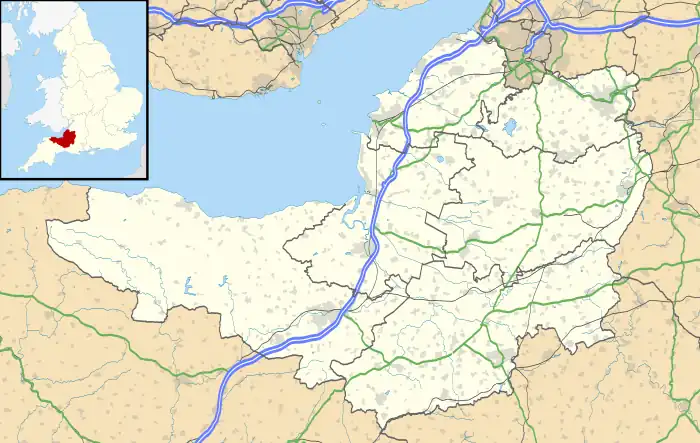| Castle House | |
|---|---|
 | |
| Location | Bridgwater, Somerset, England |
| Coordinates | 51°07′45″N 3°00′08″W / 51.12917°N 3.00222°W |
| Built | 1851 |
Listed Building – Grade II* | |
| Official name | Castle House |
| Designated | 16 December 1974[1] |
| Reference no. | 1355168 |
 Location of Castle House in Somerset | |
Castle House is a house in Bridgwater, Somerset, England. Castle House is associated with two important Sedgemoor families, the Boards and the Ackermans; John Board (1802-1861) who extended his family's brick company into cement in 1844, and his grandson William Ackerman who joined the company in 1871 and is credited with the first ‘true’ Portland cement.’ Built in 1851 to resemble a Tudor gatehouse, the construction uses panels of prefabricated concrete, with significant further usage of concrete throughout the building.
Building
The house was built in 1851 for William Ackerman.[2] Much of the building is made of brick but it was one of the first buildings to make extensive use of Portland cement for pre-cast concrete.[3] The house is two storeys high and designed to look like an ornate Tudor gatehouse. Bays to the sides of the building form stairwells.[2] The building includes many ornamental, and some structural uses of concrete demonstrating "an innovative interpretation of traditional masonry features in concrete".[4] It was designated as a Grade II* listed building on 16 December 1974.[1] Inside, the building includes more concrete features, such as the staircase, the handrails and the window frames.[2]
Renovation
Castle House was a finalist in the 2nd BBC television series Restoration in 2004 and was supported by friends of Joe Strummer.[5]
It is included in the Heritage at Risk Register produced by English Heritage,[6] and English Heritage provided funding for the restoration project.[7]
In 2012 a grant of £300,000 was made by NNB Generation Company (part of Électricité de France) as part of monies paid to the local community for the development of Hinkley Point C nuclear power station to the SAVE Trust for the restoration of Castle House.[8] It was planned to transfer the building to the Bridgwater carnival once restoration was complete.[9]
In 2018 the scaffolding was finally removed as restoration of the façade was completed. Planning permission to convert the building into three flats had been obtained.[10]
References
- 1 2 "Castle House". historicengland.org.uk. English Heritage. Retrieved 31 August 2016.
- 1 2 3 "Castle House, Bridgwater". British Listed Building. Retrieved 31 August 2016.
- ↑ Warren, Derrick (2005). Curious Somerset. Stroud: Sutton Publishing. p. 24. ISBN 978-0-7509-4057-3.
- ↑ "Castle House, Queen Street (South side), Bridgwater". Somerset Historic Environment Record. Somerset County Council. Retrieved 31 August 2016.
- ↑ Jury, Louise (7 July 2004). "Bridgewater calling: Strummer's friends want concrete folly turned into memorial". The Independent. Retrieved 31 August 2016.
- ↑ "South West England". Heritage at Risk. English Heritage. Archived from the original on 11 September 2016. Retrieved 31 August 2016.
- ↑ "The SAVE Trust - Castle House". Save Britain's Heritage. Archived from the original on 28 February 2014. Retrieved 31 August 2016.
- ↑ "Deed of Development Consent Obligations pursuant to section 106 of the Town and Country Planning Act 1990 relating to Hinkley Point C, Somerset" (PDF). UK Government. pp. 48–49. Archived from the original (PDF) on 4 March 2016. Retrieved 31 August 2016.
- ↑ "Architectural Fund 2012". Andrew Lloyd Webber Foundation. Archived from the original on 19 September 2016. Retrieved 31 August 2016.
- ↑ "Bridgwater's miniature castle restored after £600k revamp". BBC. Retrieved 18 November 2018.